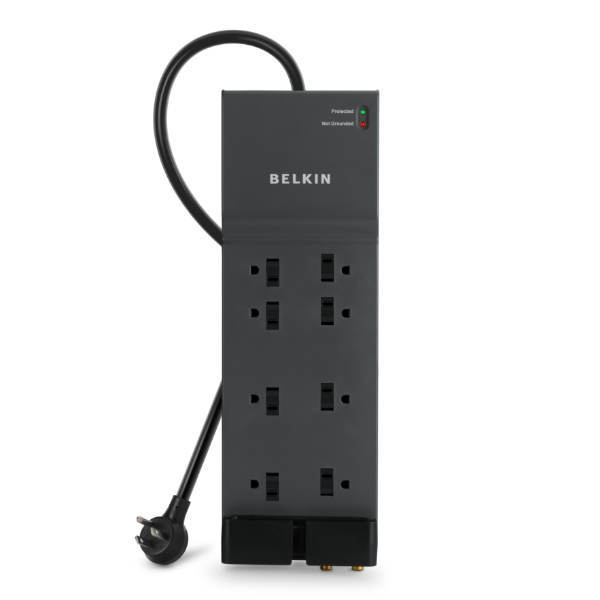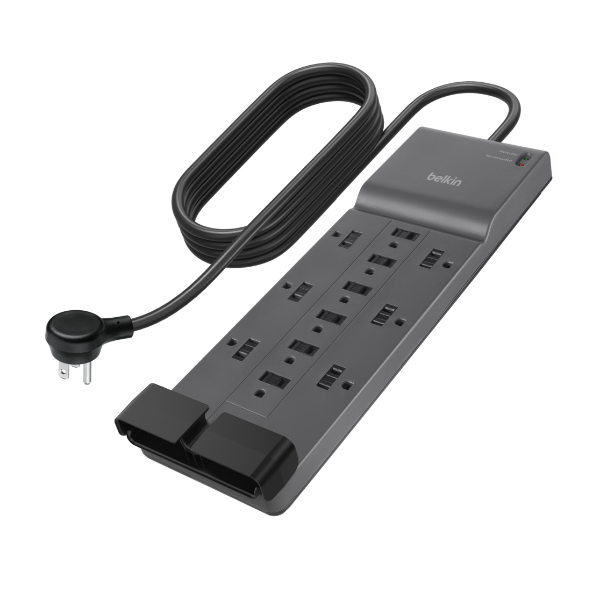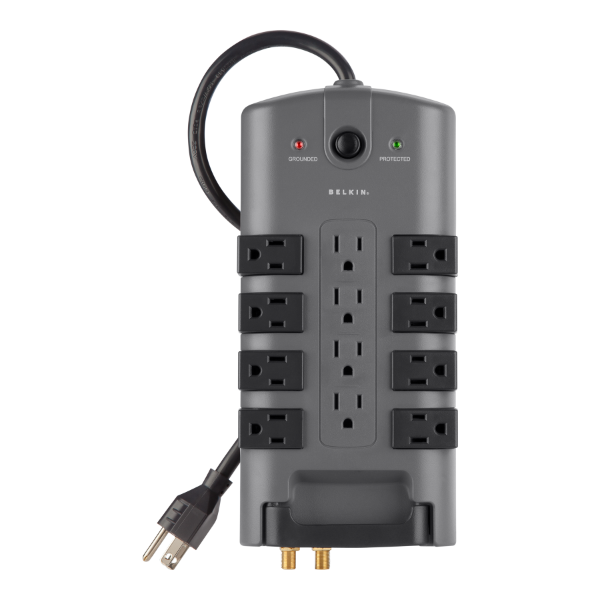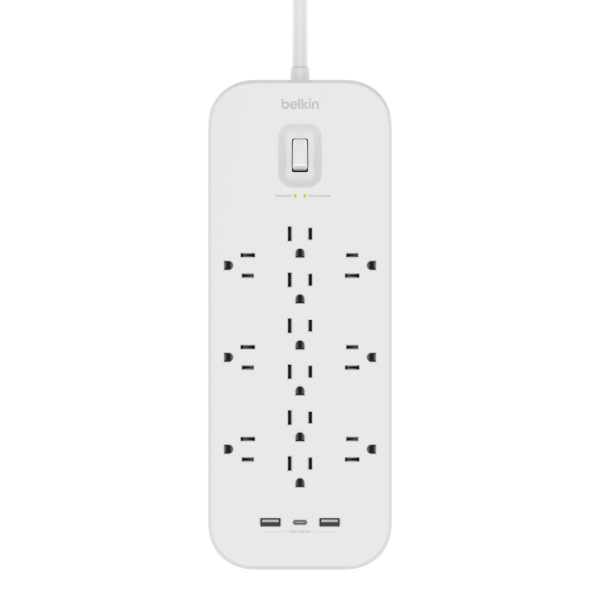Choosing the Best Surge Protector
for Your Home Office
April 24, 2025
Imagine a sudden lightning storm or power surge striking your neighborhood—this brief spike of electricity could fry your computer, monitor, or printer. Power surges, even split-second ones, can damage or destroy home electronics by sending tens of thousands of volts through your wires. For home office users, this is a serious risk: valuable equipment and irreplaceable data could be lost in an instant. Surges come from many sources beyond lightning, including everyday appliances like air conditioners or fridges cycling on and off, which can gradually wear down electronics.
The good news is that a quality surge protector can shield your devices from voltage spikes, prolong their lifespan, and protect your work and wallet. In this guide, we’ll explore why surge protectors are essential, what features to look for, and how to choose the best Belkin surge protector for your home office.
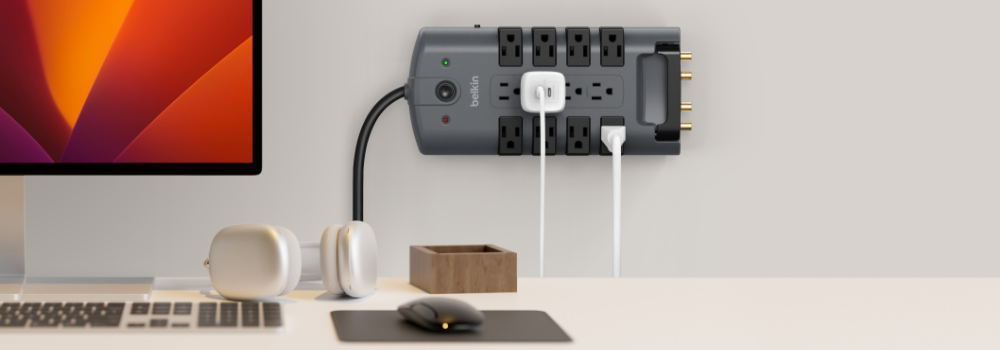
Why a Surge Protector is Essential for Your Home Office
Frequent Surges and Their Damage:
- Power surges happen multiple times a day, both internally (appliances, HVAC) and externally (utility grid, downed lines).
- Even small daily surges cause gradual damage, shortening the lifespan of your electronics.
- Sensitive devices like computers and smart gadgets can fail or lose data due to unstable voltage.
- Surge protection is essential to keep your equipment reliable and prevent premature failure.
Power Strips vs. Surge Protectors:
- Not all multi-outlet strips offer surge protection—standard power strips only extend outlets.
- Surge protectors have built-in components, like MOVs, to divert excess voltage away from devices.
- Always choose a surge protector with a joule rating or UL certification for reliable protection.
- Areas with frequent thunderstorms or homes with many appliances require surge protectors for extra security.
Protecting Your Home Office Investment:
- Home offices rely on devices that are costly and house valuable data.
- A good surge protector shields electronics from voltage spikes, preventing expensive repairs.
- Surge protectors help protect devices from both large surges and smaller fluctuations.
- Investing in surge protection extends the life of your equipment and keeps data safe.
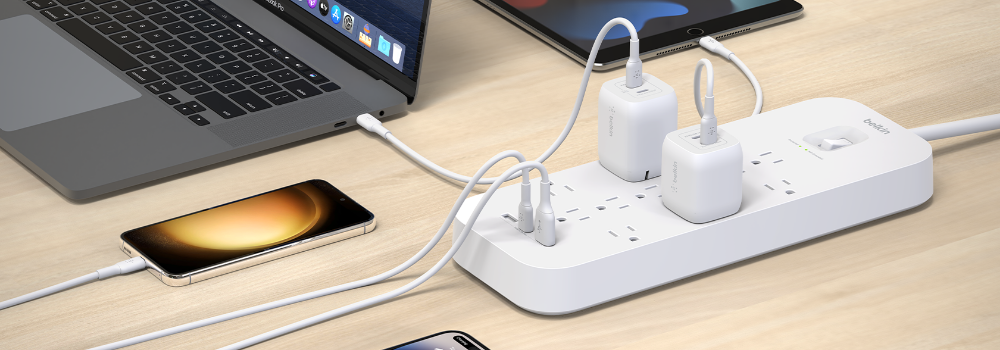
Key Features to Look for in a Surge Protector
Not all surge protectors are created equal. When shopping for the best one for your needs (especially from a trusted brand like Belkin), pay attention to these key features to ensure you’re getting effective protection and convenience:
Joule Rating
- The joule rating indicates how much energy a surge protector can absorb before it fails.
- A higher joule rating means more surge energy can be handled, providing greater protection.
- For a home office, look for surge protectors with at least 600+ joules or higher (Belkin models can go over 3000J).
- The higher the joule rating, the better your devices are protected from large surges or multiple smaller ones.
Clamping Voltage
- Clamping voltage is the threshold at which the protector diverts excess voltage.
- A lower clamping voltage means the protector reacts faster to surges, offering better protection.
- Look for surge protectors with a clamping voltage around 330–400V (lower is better).
- Belkin models have low enough clamping voltage to meet UL standards for effective surge protection.
Response Time
- Response time measures how quickly a surge protector reacts to a surge, often in nanoseconds.
- Faster response times reduce the exposure of your devices to surges, minimizing damage.
- Look for surge protectors with a response time of less than 1 nanosecond or a few hundred picoseconds.
- Many Belkin surge protectors feature ultra-fast response circuitry for near-instantaneous protection.
LED Indicating Lights
- LED lights indicate whether your devices are properly protected and if the outlet is grounded.
- Helps you quickly identify protection issues and ensures ongoing safety for your equipment.
Complete 3-Line Protection
- Protects appliances from surges across all three lines—hot, neutral, and ground.
- Provides comprehensive defense against electrical damage and sudden lightning storms to improve overall safety.
Number of Outlets
- Consider how many devices you need to plug in and their power requirements.
- Choose a surge protector with extra outlets for future growth.
- Belkin offers models with 6-12 outlets, ideal for multi-monitor setups and large equipment.
- High-draw items like space heaters, hair dryers, and refrigerators need their own dedicated surge protector.
- Check the wattage capacity of your surge protector (e.g., 1000W, 1500W, or 1800W) and match it with your devices' power needs.
- Exceeding the surge protector’s wattage could pose a safety hazard.
- Look for designs with widely spaced or pivoting outlets to accommodate bulky plugs and adapters.
- Choose a surge protector with the right form factor for your space (slim profile or wall-mount style).
USB Charging Ports
- Surge protectors with built-in USB ports (USB-A, USB-C) offer charging convenience for phones, tablets, and other devices.
- This feature frees up AC outlets for computers and other equipment.
- Some Belkin models include USB-A and USB-C ports, even supporting fast charging for smartphones and tablets.
Warranty and Equipment Protection Policy
- Look for surge protectors that come with a warranty on the device and a Connected Equipment Warranty (CEW) for your gadgets.
- Many Belkin surge protectors are backed by a lifetime warranty and CEW, covering repairs or reimbursements for damaged devices.
- A higher CEW amount (e.g., $50,000–$300,000) shows a robust design and offers peace of mind.
- Always check warranty details to ensure your devices are covered in case something goes wrong.

Types of Surge Protectors: Which One is Right for You?
Surge protectors come in a few different types and form factors. Picking the right kind depends on your specific home office needs and budget. Here are the main categories and who they’re best suited for:
- Basic Surge Protectors: Budget-friendly, great for small setups (laptop, lamp, or one PC). Protects against common surges but offers lower joules and fewer features. Ideal for minimal gear and Wi-Fi routers.
- Advanced Surge Protectors: For larger home offices or high-end electronics. More outlets (8–12), higher joule ratings (2000+ J), and extras like phone, coax, and USB protection. Best for multiple devices and expensive gear.
- Surge Protectors with Battery Backup (UPS): Protects against surges and keeps devices running during power outages. Perfect for sensitive data or critical equipment. Offers time to save work or shut down during brief outages.
- Whole-Home Surge Protection: Installed at the electrical panel, it protects your entire home. Ideal for homes with valuable appliances and electronics, especially in areas prone to storms. Requires professional installation and a higher investment.
If you just have a few low-power devices, a basic protector works; for larger setups or multiple devices, go for a higher-capacity surge strip or a UPS. For full-home protection, consider whole-home surge protection.
How to Properly Use and Maintain Your Surge Protector
Buying a quality surge protector is step one – step two is using it correctly and maintaining it so it can do its job effectively. Here are some tips to ensure your home office surge protector provides the best protection over its lifetime:
- Placement & Setup: Keep your surge protector off the floor, away from water, and ensure airflow. Use a flat plug for tight spaces. Plug directly into a grounded wall outlet—no daisy-chaining or heavy appliances.
- Regular Checks & Testing: Check the "Protected" and "Grounded" LED lights. If the light is off or red, replace the protector. After storms or surges, double-check for damage. Use a reset button to test functionality.
- Replacement: Surge protectors degrade over time. Replace every 3-5 years or after a major surge. Signs of wear include a dark “protected” light, physical damage, or a tripped breaker. Dispose of old protectors properly and replace promptly to maintain protection.
A well-maintained surge protector gives you reliable shielding against power spikes, whereas a neglected one might look fine but not intervene when a surge strikes. Take a few moments every now and then to ensure your protector (and thus your equipment) is in good shape.
Belkin Surge Protector Recommendations
To help you choose the right surge protector, here are a few Belkin models popular for home office use, compared by their features:
Comparison Tip: Choose a model based on your setup size and needs. Smaller setups can use a 6-outlet, while larger setups benefit from 8 or 12-outlet models with extra features. More capacity ensures better protection. Your home office is more than just a workspace – it’s an investment in hardware and information. Don’t let an unpredictable power surge undo that in a heartbeat.
We’ve seen that power surges are a real threat to electronics, but also that a proper surge protector acts as cheap insurance, guarding against everything from minor voltage fluctuations to major spike events. By understanding surge protector features (joules, clamping voltage, etc.) and choosing the right type for your needs, you can significantly reduce the risk of damage to your gear. Remember to use your surge protectors correctly and replace them as needed, so your defense is always at full strength.
Now is a great time to evaluate your own home office setup – are all your important devices plugged into surge-protected outlets? If not, consider adding a quality Belkin surge protector to your system. It only takes one rogue surge to wreak havoc, but with the right protection in place, you’ll be safe and sound. In summary, protecting your electronics is much easier (and cheaper) than repairing or replacing them after a surge. Don’t wait for a close call or a fried hard drive to take action.
We hope you enjoyed this post!
Explore more on the Belkin Blog,
or sign up for email and text alerts: get the latest blog updates, product announcements, and exclusive deals delivered right to you.

